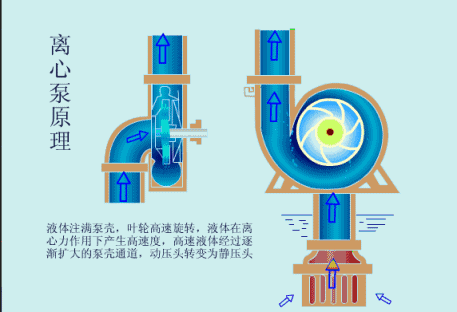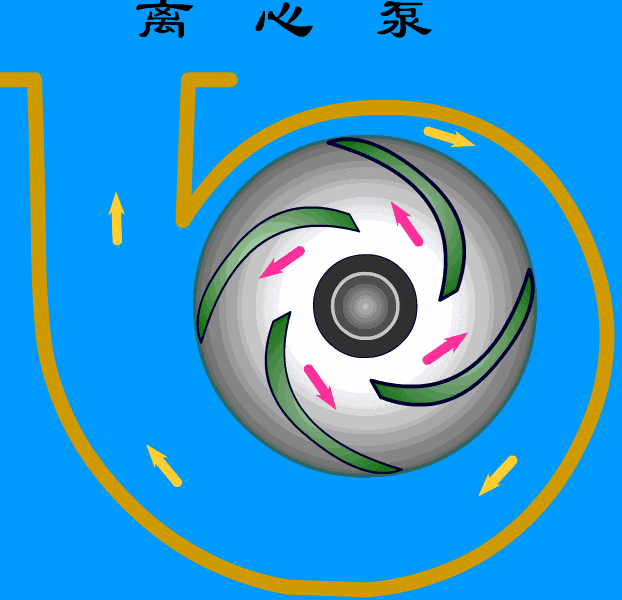
1. What is the main working principle of a centrifugal pump?
The motor drives the impeller to rotate at high speed, causing the liquid to generate centrifugal force. Due to the centrifugal force, the liquid is thrown into the side channel and discharged from the pump, or enters the next impeller, thereby reducing the pressure at the impeller inlet, and forming a pressure difference with the pressure acting on the suction liquid. The pressure difference acts on the liquid suction pump. Due to the continuous rotation of the centrifugal pump, the liquid is continuously sucked in or discharged.
2. What are the functions of lubricating oil (grease)?
Lubricating and cooling, flushing, sealing, vibration reduction, protection, and unloading.
3. Which three levels of filtration should the lubricating oil go through before use?
First level: between the original barrel of lubricating oil and the fixed barrel;
Second level: between the fixed oil barrel and the oil pot;
Third level: between the oil pot and the refueling point.
4. What is the "five determinations" of equipment lubrication?
Fixed point: refuel at the specified point;
Timing: refuel the lubricating parts at the specified time and change the oil regularly;
Quantity: refuel according to the consumption quantity;
Quality: select different lubricating oils according to different models and keep the oil quality qualified;
Specified person: each refueling part must be responsible for a dedicated person.
5. What are the hazards of water in the pump lubricating oil?
Water can reduce the viscosity of the lubricating oil, weaken the strength of the oil film, and reduce the lubrication effect.
Water will freeze below 0℃, which seriously affects the low-temperature fluidity of the lubricating oil.
Water can accelerate the oxidation of the lubricating oil and promote the corrosion of low-molecular organic acids to metals.
Water will increase the foaming of the lubricating oil and make it easy for the lubricating oil to produce foam.
Water will cause metal parts to rust.
6. What are the contents of pump maintenance?
Seriously implement the post responsibility system and equipment maintenance and other rules and regulations.
Equipment lubrication must achieve "five determinations" and "three-level filtration", and the lubricating equipment must be complete and clean.
Maintenance tools, safety facilities, fire-fighting equipment, etc. are complete and intact and neatly placed.
7. What are the common standards for shaft seal leakage?
Packing seal: less than 20 drops/min for light oil and less than 10 drops/min for heavy oil
Mechanical seal: less than 10 drops/min for light oil and less than 5 drops/min for heavy oil

8. What should be done before starting the centrifugal pump?
Check whether the pump body and outlet pipelines, valves, and flanges are tightened, whether the ground angle bolts are loose, whether the coupling (wheel) is connected, and whether the pressure gauge and thermometer are sensitive and easy to use.
Turn the wheel 2~3 times to check whether the rotation is flexible and whether there is any abnormal sound.
Check whether the quality of the lubricating oil is qualified and whether the oil volume is kept between 1/3 and 1/2 of the window.
Open the inlet valve and close the outlet valve, open the pressure gauge manual valve and various cooling water valves, flushing oil valves, etc.
Before starting, the pump that transports hot oil must be preheated to a temperature difference of 40~60℃ with the operating temperature. The heating rate shall not exceed 50℃/hour, and the maximum temperature shall not exceed 40℃ of the operating temperature.
Contact the electrician to supply power.
For non-explosion-proof motors, start the fan or apply explosion-proof hot air to blow away the flammable gas in the pump.
9. How to switch the centrifugal pump?
First, all preparations before starting the pump should be done, such as preheating the pump. According to the pump's outlet flow, current, pressure, liquid level and other related parameters, the principle is to start the standby pump first, wait for all parts to be normal, and after the pressure comes up, slowly open the outlet valve, and slowly close the outlet valve of the switched pump until the outlet valve of the switched pump is completely closed, and stop the switched pump, but the fluctuation of parameters such as flow caused by switching should be minimized.
10. Why can't the centrifugal pump start when the disc does not move?
If the centrifugal pump disc does not move, it means that there is a fault inside the pump. This fault may be that the impeller is stuck or the pump shaft is bent too much, or the dynamic and static parts of the pump are rusted, or the pressure inside the pump is too high. If the pump disc does not move and is forced to start, the strong motor force drives the pump shaft to rotate forcefully, which will cause damage to the internal parts, such as pump shaft breakage, twisting, impeller crushing, motor coil burning, and may also cause the motor to trip and start failure.
11. What is the role of sealing oil?
Cooling sealing parts; lubricating friction; preventing vacuum damage.
12. Why should the standby pump be rotated regularly?
There are three functions of regular cranking: preventing scale from getting stuck in the pump; preventing the pump shaft from deforming; cranking can also bring lubricating oil to various lubrication points to prevent the shaft from rusting. Lubricated bearings are conducive to immediate start-up in an emergency.
13. Why should the hot oil pump be preheated before starting?
If the hot oil pump is started without preheating, the hot oil will quickly enter the cold pump body, causing uneven heating of the pump body, large thermal expansion of the upper part of the pump body and small thermal expansion of the lower part, causing the pump shaft to bend, or causing the mouth ring on the pump body and the seal of the rotor to get stuck; forced starting will cause wear, shaft sticking, and shaft breakage accidents.
If high-viscosity oil is not preheated, the oil will condense in the pump body, causing the pump to not be able to flow after starting, or the motor will trip due to the large starting torque.
Due to insufficient preheating, the heat expansion of various parts of the pump will be uneven, causing leakage of static sealing points. Such as leakage of outlet and inlet flanges, pump body cover flanges, and balance pipes, and even fires, explosions and other serious accidents.
14. What should be paid attention to when preheating the hot oil pump?
The preheating process must be correct. The general process is: pump outlet pipeline → inlet and outlet cross-line → preheating line → pump body → pump inlet.
The preheating valve cannot be opened too wide to prevent the pump from reversing.
The preheating speed of the pump body should generally not be too fast and should be less than 50℃/h. In special cases, the preheating speed can be accelerated by providing steam, hot water and other measures to the pump body.
During preheating, the pump should be rotated 180° every 30~40 minutes to prevent the pump shaft from bending due to uneven heating up and down.
The cooling water system of the bearing box and pump seat should be opened to protect the bearings and shaft seals.
15. What should be paid attention to after the hot oil pump is stopped?
The cooling water of each part cannot be stopped immediately. The cooling water can only be stopped when the temperature of each part drops to normal temperature.
It is strictly forbidden to wash the pump body with cold water to prevent the pump body from cooling too fast and deforming the pump body.
Close the outlet valve, inlet valve, and inlet and outlet connecting valves of the pump.
Turn the pump 180° every 15 to 30 minutes until the pump temperature drops below 100°C.
16. What are the reasons for abnormal heating of centrifugal pumps in operation?
Heating is the manifestation of mechanical energy being converted into thermal energy. Common reasons for abnormal heating of pumps are:
Heating accompanied by noise is usually caused by damage to the bearing ball isolation frame.
The bearing sleeve in the bearing box is loose, and the front and rear glands are loose, causing heating due to friction.
The bearing hole is too large, causing the outer ring of the bearing to loosen.
There are foreign objects in the pump body.
The rotor vibrates violently, causing the sealing ring to wear.
The pump is evacuated or the load on the pump is too large.
The rotor is unbalanced.
Too much or too little lubricating oil and the oil quality is unqualified.
17. What are the reasons for vibration of centrifugal pumps?
The rotor is unbalanced.
The pump shaft and the motor are not aligned, and the wheel rubber ring is aging.
The bearing or sealing ring is worn too much, forming rotor eccentricity.
The pump is evacuated or there is gas in the pump.
The suction pressure is too low, causing the liquid to vaporize or nearly vaporize.
The axial thrust increases, causing the shaft to string.
Improper lubrication of bearings and packing, excessive wear.
Bearings are worn or damaged.
Impeller is partially blocked or external auxiliary pipelines vibrate.
Too much or too little lubricating oil (grease).
The foundation rigidity of the pump is not enough, and the bolts are loose.
18. What are the standards for centrifugal pump vibration and bearing temperature?
The vibration standards of centrifugal pumps are:
The speed is less than 1500vpm, and the vibration is less than 0.09mm.
The speed is 1500~3000vpm, and the vibration is less than 0.06mm.
The bearing temperature standard is: sliding bearings are less than 65℃, and rolling bearings are less than 70℃.
19. When the pump is operating normally, how much cooling water should be opened?
Post time: Jun-03-2024

